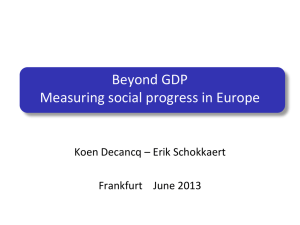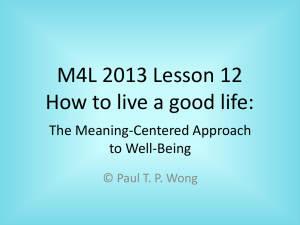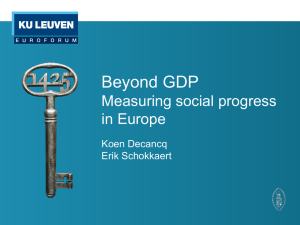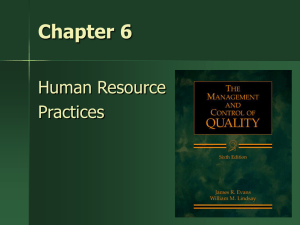happiness
advertisement
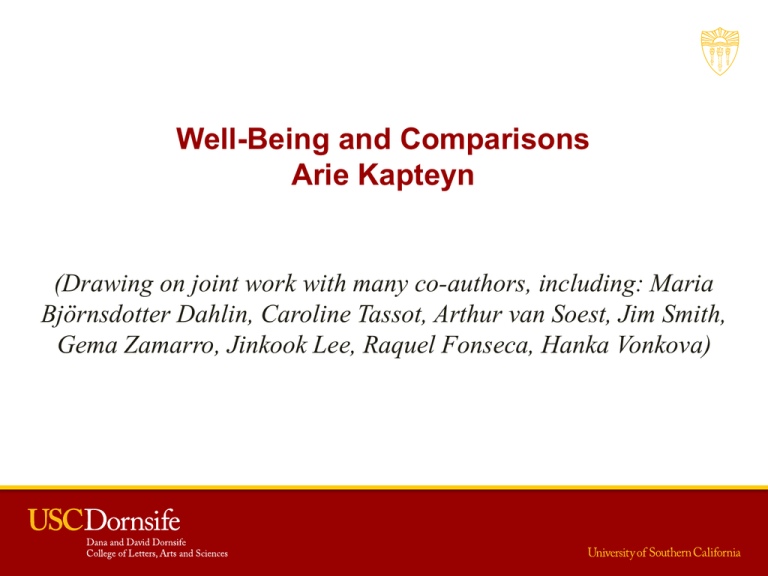
Well-Being and Comparisons Arie Kapteyn (Drawing on joint work with many co-authors, including: Maria Björnsdotter Dahlin, Caroline Tassot, Arthur van Soest, Jim Smith, Gema Zamarro, Jinkook Lee, Raquel Fonseca, Hanka Vonkova) Contents • • • • • • • • • • Increasing interest in well-being Data sources Different well-being concepts How they hang together Can we explain well-being differences? The structure of evaluative well-being Do we compare to others? Who are these others and what do we know about them? And how do they influence us? Conclusions Interest in the measurement of Subjective Well-Being has soared over the last decades, not just in Academia • France: Commission on the Measurement of Economic Performance and Social Progress* • United Kingdom: Office of National Statistics** • United States: Federal Reserve Chairman Ben Bernanke declaring his interest in finding better measurements of Americans’ well-being*** • Bhutan: Gross National Happiness**** • • • • *Stiglitz, J. E., Sen, A., & Fitoussi, J. P. (2009). Report by the commission on the measurement of economic performance and social progress. Paris: Commission on the Measurement of Economic Performance and Social Progress. **Dolan, P., Layard, R., & Metcalfe, R. (2011). Measuring subjective well-being for public policy. ***Rugaber, C. S. (2012). Are you happy? Ben Bernanke wants to know ****http://en.wikipedia.org/wiki/Gross_national_happiness National Academy of Sciences, US International Organizations Various municipalities now also measure well-being Precursors Salvador Allende’s Chile • Planned a centrally planned economy with continuous measurement of happiness: • “Beer [the designer of the system] built a device that would enable the country’s citizens, from their living rooms, to move a pointer on a voltmeter-like dial that indicated moods ranging from extreme unhappiness to complete bliss.” • (Evgeny Morozov: “The Planning Machine”, New Yorker, October 13, 2014) Data Sources • The analyses presented are based on several Internet panels in the Netherlands and in the U.S: – CentERpanel in the Netherlands (1996) – American Life Panel (ALP) at RAND (2006) – Understanding America Study (UAS) at USC (2014) – Distinctive features: • Recruiting not via Internet • Provide Internet access to potential respondents without it • Incidentally: the most complete Internet panel in the world is the LISS panel run by CentERdata at Tilburg University The American Life Panel as an Example The RAND American Life Panel Population Nationally representative Internet panel, including vulnerable population sample 5000+ respondents aged 18+, not recruited via internet Research environment Timeliness Access and Usability The RAND American Life Panel Population Research environment Nationally representative Internet panel, including vulnerable population sample Internet mode offers visualization, experiments etc 5000+ respondents aged 18+, not recruited via internet Many hours worth of background information (e.g. HRS, cognitive tests) Timeliness Access and Usability The RAND American Life Panel Research environment Timeliness Nationally representative Internet panel, including vulnerable population sample Internet mode offers visualization, experiments etc Approximately two surveys/experime nts per month (about 300 since 2006) 5000+ respondents aged 18+, not recruited via internet Many hours worth of background information (e.g. HRS, cognitive tests) Rapid turnaround Population Access and Usability The RAND American Life Panel Research environment Timeliness Access and Usability Nationally representative Internet panel, including vulnerable population sample Internet mode offers visualization, experiments etc Approximately two surveys/experime nts per month (about 250 since 2006) Data available for download for free 5000+ respondents aged 18+, not recruited via internet Many hours worth of background information (e.g. HRS, cognitive tests) Rapid turnaround Custom interface allows ability to combine waves, get data in analysis-ready format Population The panel has been used for continuous Presidential polling Address Based Sampling 1. 2. 3. 4. Draw zip-codes; buy addresses. Advance notification letter. After 1 week, 10 minute mail survey with $5 prepaid incentive. $15 for returning completed survey; survey asks for interest in study participation. Non-Internet respondents are offered a tablet and Internet. 5. 2 weeks after the survey mailing, non-respondents are mailed a reminder postcard. 6. 2 weeks after the reminder postcard is mailed, a second copy of the survey is mailed to all sample members who have not returned a complete survey. 7. 3 weeks after the second copy of the survey is mailed, follow-up phone calls, up to 15 attempts How to gauge the quality of probability based Internet panels? Krosnick and co-authors: • Various studies over the last decade. • Compare telephone, probability based Internet, convenience Internet. • Probability based Internet comes out very well (in Mean Square Error sense). Different Well-Being Concepts • Evaluative Well-Being: Evaluation of life satisfaction/ dissatisfaction • Experienced Well-Being: The combination of experienced affect - range of emotions from joy to misery. – Positive Affect – Negative Affect • Eudemonic measures refer to the existence of underlying psychological needs, encompassing various dimensions of wellness, such as autonomy, personal growth, or purpose in life. Examples • Evaluative (SHARE) – How satisfied are you with your life in general? Very satisfied / Somewhat satisfied / Somewhat dissatisfied/ Very dissatisfied • Experienced Questions – Gallup Well-Being Index – – – – – – – Did you experience anger during a lot of the day yesterday? Did you experience depression during a lot of the day yesterday? Did you experience enjoyment during a lot of the day yesterday? Did you experience happiness during a lot of the day yesterday? Did you experience sadness during a lot of the day yesterday? Did you experience stress during a lot of the day yesterday? Did you experience worry during a lot of the day yesterday? • Eudemonic (Office of National Statistics, UK): – Overall, to what extent do you feel that the things you do in your life are worthwhile? (Not at all) 0/1/2/3/4/5/6/7/8/9/10 (Completely) By combining experienced well-being with time use, one can paint a picture of well-being during the day and by activity • Day Reconstruction Method*: – A self-administered time use diary with ratings of positive and negative affect for each period. • What do we like most and what do we like least? – Most liked: Intimate relations; Socializing; Relaxing; – Least liked: Taking care of children; computer/email/internet; housework; working; commuting. *Kahneman, D., Krueger, A. B., Schkade, D. A., Schwarz, N., & Stone, A. A. (2004b). A survey method for characterizing daily life experience: The day reconstruction method. Science, 306(5702), 1776-1780. Diurnal Patterns (from Kahneman et al. 2004) Fig. 1. Comparison of diurnal patterns of tiredness (A) and negative affect (B) for DRM and ESM studies. D Kahneman et al. Science 2004;306:1776-1780 Published by AAAS Relation of the Different Measures • It appears that evaluative and eudemonic measures are hard to distinguish empirically (they form one factor in factor analysis) • Experienced well-being can be decomposed in a positive and a negative factor • So we have three factors in total Kapteyn, A., Lee, J., Tassot, C., Vonkova, H., and Zamarro, G., “Dimensions of Subjective Well-Being”, Social Indicators Research, forthcoming (DOI 10.1007/s11205-014-0753-0; available online at: http://link.springer.com/article/10.1007/s11205-014-07530?sa_campaign=email/event/articleAuthor/onlineFirst ). Based on ALP data Example of Experienced Well-Being Scale (Kapteyn, et al. 2014) Happy Interested Frustrated Sad Enthusiastic Content Angry Tired Stressed Lonely Worried Bored Pain Depressed Joyful Negative Affect -0.32 -0.10 0.80 0.79 -0.13 -0.26 0.76 0.62 0.79 0.68 0.78 0.54 0.57 0.78 -0.21 Positive Affect 0.83 0.82 -0.26 -0.24 0.83 0.76 -0.16 -0.15 -0.23 -0.20 -0.19 -0.25 -0.06 -0.31 0.84 Can we explain well-being differences? Life Satisfaction (SHARE) and Income 0.25 0.2 0.15 Life Satisfaction (SHARE) 0.1 0.05 0 <$25,000$ $25,000-$49,999 $50,000-$74,999 $75,000-$99,999 >$100,000 Life Satisfaction and Age Life Satisfaction (SHARE) 0.35 0.3 0.25 0.2 Life Satisfaction (SHARE) 0.15 0.1 0.05 0 <25 25-34 35-44 45-54 55-64 65+ Life Satisfaction and Employment Status Life Satisfaction (SHARE) 0.45 0.4 0.35 0.3 0.25 Life Satisfaction (SHARE) 0.2 0.15 0.1 0.05 0 Retired Other work Working now Disabled Unemployed Experienced Well-Being and Age 0.5 0.45 0.4 0.35 0.3 Negative Affect 0.25 Positive Affect 0.2 0.15 0.1 0.05 0 <25 25-35 35-45 45-55 55-65 65+ Experienced Well-Being and Income (Nothing Significant) 0.2 0.18 0.16 0.14 0.12 Negative Affect 0.1 Positive Affect 0.08 0.06 0.04 0.02 0 <$25,000$ $25,000-$49,999 $50,000-$74,999 $75,000-$100,000 >$100,000 Experienced Well-Being and Employment Status 0.7 0.6 0.5 0.4 Negative Affect Positive Affect 0.3 0.2 0.1 0 Unemployed Retired Disabled Other work Working now More on Retirement (SHARE and HRS): Correlations Depression, Life Retirement, Retirement, Depression Life Satisfaction Satisfaction Austria Belgium Denmark France Germany Greece Italy Netherlands Spain Sweden Switzerland United States 0.09 0.04 0.01 0.05 0.06 0.15 0.09 0.09 0.17 0.08 0.07 0.08 -0.05 -0.01 -0.04 -0.08 -0.07 -0.15 -0.09 -0.04 -0.07 -0.04 -0.04 0.02 -0.41 -0.28 -0.29 -0.3 -0.32 -0.26 -0.35 -0.26 -0.38 -0.28 -0.31 -0.34 Total 0.1 -0.03 -0.31 However, this is not causal* • A structural model, using country institutions as instrumental variables shows: – Retirement reduces depression – Retirement increases life satisfaction • And as a bonus: – A strong effect of unemployment replacement rates on the life satisfaction of the unemployed. Fonseca, R., Kapteyn, A., Lee, J., Zamarro, G. (2014), “Does Retirement Make you Happy? A Simultaneous Equations Approach”, Working Paper, CESR, University of Southern California. Based on SHARE and HRS data The structure of evaluative well-being • We can explain overall life satisfaction by satisfaction with life domains*. Here are the relative weights: 0.45 0.4 0.35 0.3 0.25 Netherlands 0.2 U.S. 0.15 0.1 0.05 0 Relations • Job/daily activities Health Income *Kapteyn, A., Smith, J., and Van Soest, A., “Life Satisfaction,” in: Ed Diener, John F. Helliwell, Daniel Kahneman (eds.) International Differences in Well-Being, Oxford University Press, 2010, 70-104. Using CentERpanel and ALP Comparisons To evaluate how we are doing, we need a frame of reference • That frame can be our own past, or we can compare with others. • Who are these others, what do we know about them, and how do they influence us? • So we* asked: – Who do you compare yourself to (in various life domains) – Where do you think you stand? – Where do you think others (friends, people in your street, etc.) stand? • Next we used that information to explain individual happiness and satisfaction in several domains – Today I am mainly talking about the income domain. Dahlin M.B., Kapteyn A., Tassot, C. (2014), “Who are the Joneses?” CESR Working Paper 2014-004; using ALP Data • American Life Panel (5,475 respondents) • Questions about – Happiness – Satisfaction with life domains – Comparison groups – Comparison intensity • Zip-code data from American Community Survey (about 3 million households annually) • IRS (tax) data • Information on crime, local and state taxes Dependent Variables How happy are you? • Very Happy • Happy • Neither happy nor unhappy • Unhappy • Very unhappy How satisfied are you with the total income of your household? • Very satisfied • Satisfied • Neither satisfied nor dissatisfied • Dissatisfied • Very dissatisfied. Subjectively measured own income Perceived Income of Others Who Matters Most? Happiness 100% 90% 22.4 80% 70% 60% 50% 57.2 40% 30% 20% 15.8 10% 0% Very unhappy Neither happy nor unhappy Very happy 4.1 0.5 Unhappy Happy Satisfaction with Domains 100% 6.7 90% 28.1 14.7 14.8 48.0 47.8 20.2 17.6 13.5 16.6 3.7 3.3 Job / daily activities Health 27.1 80% 36.0 70% 60% 50% 23.0 50.3 46.0 40% 30% 20% 26.7 16.6 12.8 10% 7.6 0% HH income 7.5 1.4 Family life Very dissatisfied Neither satisfied nor dissatisfied Very satisfied 8.8 1.5 Number of friends Dissatisfied Satisfied Percentage of sample reporting comparison intensity 6-10 Who do we compare to? 70 60 50 40 30 20 10 0 Family, friends and acquaintances Coworkers and colleagues Health People my age People living on People living in People in the US my street my town Friends Family Job Household income People in the world Findings • Those who compare most have the highest estimate of other people’s income (and hence they rank their relative position worst) • If we consider comparisons with geographic groups (street, postal code, county, etc.) we generally find that higher incomes in these groups raise happiness or the satisfaction with own income. This suggests a public goods interpretation. • Own rank raises income satisfaction and happiness • Comparison with the own age group suggests a strong relative component (if others of my age make more money that reduces my happiness or income satisfaction) Conclusions (some more tentative than others) • Subjective Well-Being can be succinctly summarized by three dimensions: • One evaluative dimension • Two experienced dimension (one positive, one negative) • Determinants of experienced dimensions are less easy to characterize by demographics, policy variables, etc. • Evaluative well-being is partly relative (comparisons to others matter), shows stable relations with demographics (e.g. age), and is amenable to policy (e.g. income maintenance policies) • Nevertheless, more work needs to be done to gain better understanding who individuals compare themselves with.
